| |
 |
 |
| |
|
Nagorno-Karabakh
(Artsakh) |
| |
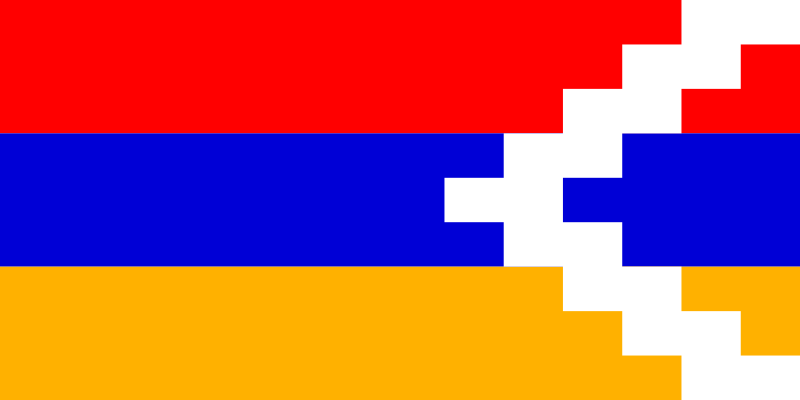 |
 |
| |
|
Nagorno-Karabakh, an ethnically Armenian enclave inside Azerbaijan (pop.,
1991 est.: 193,000), SW region. It occupies an area of 1,700 sq mi (4,400
square km) on the NE flank of the Karabakh Mountain Range, with the
capital city: Stepanakert
(Tatev 1920-1921; Shusha 1751-1822).
Russia annexed the area from Persia in 1813, and in 1923 it was established
as an autonomous province of the Azerbaijan S.S.R. In 1988 the region's
ethnic Armenian majority demonstrated against Azerbaijani rule, and in 1991,
after the breakup of the U.S.S.R. brought independence to Armenia and
Azerbaijan, war broke out between the two ethnic groups. On January 8, 1992
the leaders of Nagorno-Karabakh declared independence as the Republic of
Mountainous Karabakh (RMK). Since 1994, following a cease-fire, ethnic
Armenians have held Karabakh, though officially it remains part of
Azerbaijan. Karabakh remains sovereign, but the political and military
condition is volatile and tensions frequently flare into skirmishes. Its
marvelous nature and geographic situation, have all facilitated Karabakh to
be a center of science, poetry and, especially, of the musical culture of
Azerbaijan.
The region possesses numerous mineral springs and deposits of zinc, coal,
lead, gold, marble and limestone. The major cities of the region are
Stepanakert, which serves as the capital of the Nagorno-Karabakh Republic,
and Shusha, which lies partially in ruins. Vineyards, orchards and mulberry
groves for silkworms are developed in the valleys. |
| The sovereign
status of the Nagorno-Karabakh Republic is not recognized by any state,
including Armenia, besides Transnistria, which is itself a largely
unrecognized state. Three United Nations Security Council Resolutions (853,
874, and 884) and United Nations General Assembly resolutions 49/13 and
57/298 refer to Nagorno-Karabakh as a region of Azerbaijan. None of these
resolutions were passed under Chapter VII (Action with Respect to Threats to
the Peace, Breaches of the Peace, and Acts of Aggression) of the Charter. |
| |
c.1554 State under the rule of an Atabeg founded; part of Persia.
1588 Part of the Ottoman Empire.
1606 Khanate of Qarabagh (Karabakh) founded.
14 May 1806 Annexed to Russia by Treaty of Kurekchay.
Oct 1822 Khanate abolished by Russia.
04 Jun 1918 Treaty of Batum recognizes Karabakh as an autonomous part
of Azerbaijan.
22/26 Jul
1918 (Armenian) People's Government of Karabakh formed.
26 Aug 1919 - 09 Jun 1920 Government of Karabakh recognizes the
sovereignty of
Azerbaijan.
09 Jun 1920 Declared incorporated into Armenia.
Sep 1920 Armenia relinquished Zangezur and Karabakh to Azerbaijan, but
Armenian forces remain and Azeris could not take power.
02 Dec 1920 Azerbaidzhan S.S.R. Revolutionary Committee recognizes
Nakhichevan, Nagorno-Karabakh and Zangezur as part of
Armenian S.S.R.
25 Dec 1920 Syunik Autonomous Republic proclaimed by Armenian
forces in Syunie (Siunie) and Karabakh with capital in
Tatev which is declared to be "autonomous within Armenia."
02 Apr 1921 Republic of Syunik proclaims independence.
26 Apr 1921 Syunik reduced to only part of upper Karabakh and is
renamed
the Republic of Mountainous Armenia.
03 Jun 1921 Caucasus Bureau of the Russian Communist Party recognizes
Nagorno-Karabakh as part of Armenian S.S.R.
01 Jul 1921 Republic of Mountainous Armenia is renamed Republic of
Armenia.
05 Jul 1921 Soviet Russia occupies the area, made part of Azerbaijan.
07 Jul 1923 Nagorno-Karabakh Autonomous Oblast within Azerbaidzhan
S.S.R.
13 Feb 1988 Karabakh Armenians began demonstrating in favour of
unification with the Armenian republic
20 Feb 1988 Supreme Soviet of Nagorno-Karabakh votes to reunite with
Armenia (rejected by Supreme Soviet of U.S.S.R. on 28 Mar
1988, but recognized by Armenian S.S.R. on 15 Jun 1988).
22 Feb 1988 First direct confrontation of the conflict occurred as a
large
group of Azeris marched from Agdam against the Armenian
populated town of Askeran.
12 Jul 1988 Supreme Soviet of Nagorno-Karabakh again votes to join
Armenia
(rejected by Supreme Soviet of U.S.S.R. on 18 Jul 1988, but
ratified by Armenian S.S.R. 1 Dec 1989).
12 Jan 1989 - Aug 1991 Placed under direct Soviet
administration from Moscow.
28 Nov 1989 Autonomy abrogated by Supreme Soviet of U.S.S.R.
29 Nov 1989 Direct rule in Nagorno-Karabakh was ended and the region
was
returned to mostly Azerbaijani administration.
01 Dec 1989 During a joint session, the Supreme Soviets of Armenian
S.S.R.
and the National Council adopt a resolution on reunification
of Nagorno-Karabakh and Armenian S.S.R.
27 Aug 1990 Azerbaijan S.S.R. abolishes Nagorno-Karabakh autonomy.
02 Sep 1991 Armenian Republic of Nagorno-Karabakh (or Republic of
Mountainous Karabakh (Artsakh) declared.
26 Nov 1991 Azerbaijan declares Nagorno-Karabakh Autonomous Oblast
dissolved. It came under direct control of Azerbaijan.
06 Jan 1992 Independence declared (not internationally recognized).
19 May 1992 - date
Armenian occupation of adjacent Azeri city of Lachin
(Kelbajar from 7 Apr 1993, Aghdam 24 Jul 1993, Fizuli 23 Aug
1993, Jebrayil 26 Aug 1993 and Gubatly 31 Aug 1993, Horadiz
23 Oct 1993 - Feb 1994 and in Zangelan from 1 Nov 1993).
02 Jun 1992 Flag Adopted
17 Nov 1992 Text of National Anthem Adopted
10 Dec 2006 Constitution
Nagorno-Karabakh Republic (Artsakh Republic also in use).
27 Sep 2020 Nagorno-Karabakh line of contact and Armenia–Azerbaijan
border clashes starts. |
|
|
 |
|
|
|
|
- ARRAN
Western Azerbaijan, south of Chechnya.
-
Armenia................................................c. 80 - 55
-
Albania...............................................55 BCE - 47 CE
- The Roman
Empire..........................................47 - c. 230
- To
Persia.............................................c. 230 - 651
- Prophet Muhammad's
elected successors....................643 - 661
- Governors of Arran
- appointed by Caliph (capital at Barda
(North Azerbaijan) and from 760 Tabriz (South Azerbaijan, now within
Iran).
- Khudaifa ibn al-Yaman...............................643
- 644
- Sammak ibn al-Haris.................................644
- 645
- Utba ibn Farhad.....................................645
- 646
- al-Walid ibn Uqba...................................646
- 656
- Said ibn Sariya al-Khuzai...........................656
- 658
- Kais ibn Sa'ad al-Ansari............................658
- 660
-
Umayyad
Caliphate........................................661 - 750
- Ubaydallah ibn al-Abbas.............................660
- 663
- To Arminyah.........................................663
- 692
- Muhammad ibn Marwan.................................692
- 710
- Maslama al-Amawi (1st
time).........................710
- 720
- Tabit al-Nahrawani..................................720
- 722
- al-Djarrah ibn Abdallah.............................722
- 724
- Said ibn
Amir.......................................724 - 725
- Maslama al-Amawi
(2nd time).........................725 - 732
- Marwan ibn Muhammad (Caliph Marwan II 744-750)......732 - 744
-
Abbasid
Caliphate........................................750 - 889
- Abu Djafar Abdallah al-Mansur
(caliph 754-775)......750 - 754
- unknown ruler
- Abu al-Fazl Yahya ibn Halid
al-Barmaqi..............775 - 778
- Bistam ibn Amir al-Taglibi..........................778
- 787
- Yazid ibn Mazyad (1st
time).........................787
- 791
- He ruled at Shirvan 799-801. Arminya in
787-788 and 799-801.
- Zubaida
(female)....................................791 - 798
- Yazid ibn Mazyad
(2nd time).........................799 - 801
- Huzaima ibn Khazim..................................801
- 803
- Badjna ibn Rawad....................................803
- 812
- Hatim ibn Hatama....................................812
- 820
- Isa ibn
Muhammad....................................820 - 824
- Ali ibn Sadaka al-Ruzak...................................824
- Ibrahim ibn al-Lais.................................824
- 826
- Muhammad ibn Humaid al-Tusi.........................826
- 829
- Ali ibn Hisham......................................829
- 832
- Udjayf ibn Anbasa...................................832
- 838
- Mandjur.............................................839
- 840
- Muhammad ibn al-Rawad...............................840
- 846
- Muhammad ibn Hatim..................................847
- 848
- Hamdawayh ibn Ali al-Saadi..........................848
- 849
- Abu Abdallah Mohammad (caliph
al-Mu’tazz 866-869)...849 - 862
- Abu al-Hasan Ali....................................862 - 863
- unknown ruler
- al-Ala ibn Ahmad al-Azdi............................873
- 874
- unknown ruler
- Iranian
Azerbaijan (Sajid dynasty).......................889 - 900
- ARANSHAKHIK-MIGRANIAN (in Artsakh (Qarabagh))
- Sakhl Smbatian
(at Kuchen)....................fl.
early 800's with...
- Isaiah (at
Dizak).............................fl.
early - mid 800's
- Emirate of
Shirvan of Azerbaijan (Yazidid)............c. 900 - 1027
- Emirate of
Shirvan of Azerbaijan (Kesranid).............1027 - 1063
- Fadl appears in the history of ibn al-Athir as
"Fadhlun the Kurd". He was the first emir of Arran to issue his own
coinage, having his mint located at Partav and later Ganja. Fadl also
has the singular distinction of being the last leader in recorded
history to have been defeated in battle by the Khazars, in 1030.
According to ibn al-Athir, the Khazars killed 10,000 of Fadl's soldiers.
Some scholars believe that ibn al-Athir was either using "Khazar" as a
generic for Caucasian highlanders or else was altogether mistaken, and
that Fadl actually fought Circassians, Pechenegs or Alans. Later
references appear to individual Khazars in Russian sources, but not to
an organized state or army.
- Seljuqs.................................................1071 - c. 1120
- main rulers of
Arran
- Menuchir (at
Ani)..................................1075
- 1118
- Abu-l-Asvar
Shavur II..............................1118 - 1124
- Fadl IV ibn
Shavur II..............................1125 - ?
- Mahmud............................................... ? - 1131
- Khushchikr.........................................1131
- ?
- Shaddad..............................................
? - 1155
- Fadl
V.............................................1155 - 1161
- Shahanshah.........................................1164
- 1174
- Emirate of
Shirvan of Azerbaijan (Kesranid)..........c. 1120 - 1204
- Mongols.................................................1225 - 1278
- GASAN-DJALALID
- Gasan-Djalal (Qarabagh,
Chachen).........fl.
mid 1200's - 1261
- Mongol Ilkhans..........................................1278
- 1340
-
Jalayirid
Baghdad.......................................1340 - 1382
- Timurid
Empire..........................................1382 - 1405
- Horde of the
Black Sheep
(Kara Koyunlu).................1405
- 1468
- Qara Yusuf’s death in 1420 left his sons
Ispend, Iskander, Jahan Shah and Abu Sa’id fighting over the Succession.
The Turkoman Muzaffar al-Din Jahan Shah ibn Yusuf (1437–1467) became
ruler of this region.
- Horde of the
White Sheep
(Ak Koyunlu)...................1468
- 1502
- Persia..................................................1502 - 1516
-
Ottoman
Empire..........................................1516 - 1539
- Persia..................................................1539 - 1548
-
Ottoman
Empire..........................................1548 - 1578
- Derbendi dynasty
of Azerbaijan
- Abu Bakr Mirza ibn Burhan
Ali..................................1578
-
Ottoman
Empire.................................................1578
- Persia..................................................1578 - 1579
-
Ottoman
Empire..........................................1579 - 1607
- Persia..................................................1607 - 1721
- Russia..................................................1721 - 1732
- Qarabagh as
Vassals of Persia
- In c. 1554 Qarabagh state under the rule
of Atabeg founded. It became part of Ottoman Empire 1588-1606.
Khanate founded in 1606.
- Dawud
Khan.........................................1722 - May 1728
- Makhtihar..........................................1728
- 1730
- Ughurlu Khan
Ziyadoghlu............................1730 - 1738
- Khan
Chemskeseka..........................................fl. 1740's
- Persia..................................................1732 - 1747
- DJEVANSHIR
- Panah Khan Ali
Beg......................................1747 - 1761
- Ibrahim Khalil
Khan.....................................1761 - 14 Jun 1806
- Mahdi Quli Khan
Muzaffar................................1806 - Oct 1822 d. 1845
- Qarabagh has become a thorny source of
contention between Azerbaijan and Armenia in modern times. The region
was populated by large numbers of Armenian migrants during the 19th
century, and when the Soviet Union broke up in 1991, an Armenian
insurgency dating from 1987 erupted into open warfare with Azerbaijan,
with whom the territory has been incorporated into since Tsarist times.
- Russia.............................................Oct 1822 - 1918
- Viceroys of
Transcaucasia (including Armenia and Azerbaijan)
- Mikhail
Semyonovich (Prince Vorontsov)...........1845 - 1853 d. 1856
- Nikolai
Nikolaievich Muravyov....................1854 - 1856
- Prince
Aleksandr Ivanovich Baryatinsky...........1856 - 1862
- Grand Duke
Mikhail Nikolaievich Romanov..........1862 - 1881 d. 1909
- Civil
Administrators of the Caucasus
- Pr. Aleksandr
Mikhailovich Dondukov-Korsakov.....1882 - 1890 d. 1893
- Sergei
Aleksandrovich Sheremetyev................1890 - 1896 d. 1896
- Prince
Grigorii Sergeievich Golitsyn.............1896 - 1904 d. 1907
- Yakov
Dmitriyevich Malama (acting)...............1904
- 1905 d. 1912
- Viceroys
- Count Illarion
Ivanovich Vorontsov-Dashkov.......1905 - 1915 d. 1916
- Grand Duke
Nikolai Nikolaievich Romanov..........1915 - 1917 d. 1929
- Transcaucasian
Republic........................24 Feb 1918 - 26 May 1918
- Nikoloz Semyonovich Chkheidze..................23
Feb 1918 - 26 May 1918
- On February 10, 1918, the Sejm gathered and
made the decision to establish independence. On February 24, 1918, The
Sejm proclaimed the "Transcaucasian Democratic Federative Republic".
Remaining in Georgia, he became leader of the Transcaucasian Sejm on
February 23, 1918 and in May was elected a Chairman of the Constituent
Assembly of the newly-proclaimed Democratic Republic of Georgia. On
March 3, 1918, the armistice of Erzincan followed up with the Treaty of
Brest-Litovsk marking Russia's exit from World War I. In the Treaty of
Brest-Litovsk, the Ottoman Empire regained Batum, Kars, and Ardahan.
Between March 14 and April 1918 the Trabzon peace conference was held
between the Ottoman Empire and a delegation of the Sejm. On April 05,
the head of the Transcaucasian delegation, Akaki Chkhenkeli, accepted
the Treaty of Brest-Litovsk. On May 11, 1918, a new peace conference
opened at Batum. At this conference the Ottomans extended their demands
to include Tiflis as well as Alexandropol and Echmiadzin, where they
wanted to build a railroad to connect Kars and Julfa with Baku. The
Armenian and Georgian members of the Republic’s delegation began to
stall. Beginning on May 21, the Ottoman army moved ahead once again. The
conflict led to the Battle of Sardarapat (May 21–29), the Battle of Kara
Killisse (May 24–28), and the Battle of Bash Abaran (May 21–24). On May
26, 1918, Georgia (Democratic Republic of Georgia) declared
independence; two days later, on May 28, Armenia (Democratic Republic of
Armenia) and Azerbaijan (Azerbaijan Democratic Republic) followed suit,
dissolving the federation. The day is commemorated by both countries as
Republic Day.
- Azerbaijan
Democratic Republic.................28 May 1918 - 27 Apr 1920
- President of
Karabakh Sovereignty Committee
- Lyuftali-bek
Byebutov............................1917 - Sep 1918
- President of
Karabakh Armenian National Council
- Yeghishe
Ishkhanyan..........................Sep 1918 - 1919
- Governor of Karabakh
- Khosrov bey
Sultanov......................15 Jan 1919 - May 1920
- President of
Authority
- Arsen Ogannesyan.............................Apr
1920 - 1920
- President of the
Revolutionary Committee
- Sako Ambartsumyan.......................................1920
- Soviet
Union...................................27 Apr 1920 - 25 Dec 1991
- Karabakh Sparapet
(Commander)
- Garegin Egishevich
Ter-Arutyunian............Apr 1921 - Jul 1921
- First
Secretaries of the Oblast Committee of the Communist Party
- Sero Manutsyan...............................Jul
1923 - Dec 1923
- Akop
Mikaelovich Bendzhanyan.................Dec 1923 - Apr 1924
- Sarkisov.....................................Apr
1924 - Oct 1924
- Hayk
Hachaturovich Silanyan..................Oct 1924 - 1925
- Artvazd
Aleksandrovich Saakyants.................1925 - 1929
- M.K. Danilyan
...................................1929 - Dec 1929
- Ashot
Abramovich Karamyan........................1929 - May 1930
- unknown person May 1930 - Jul 1938.
- Mikhail
Sergeyevich Manukyants...............Jul 1938 - Oct 1942
- Yegishe
Petrosovich Grigoryan (1st
time).....Oct
1942 - 1946
- Tigran
Grigoryevich Grigoryan....................1956 - 1951
- Yegishe
Petrosovich Grigoryan (2nd
time).........1952
- Dec 1958
- Nikolay
Samsonovich Shakhnazarov.............Dec 1958 - Oct 1962
- Gurgen
Allakhverdovich Melkumyan.............Oct 1962 - Jun 1973
- Boris
Sarkisovich Kevorkov...................Jun 1973 - 24 Feb 1988
- Genrikh
Andreyevich Pogosyan..............24 Feb 1988 - 20 Jan 1989
- Vagan
Gabrielyan..........................20 Jan 1989 - 27 Aug 1990
- Republic of
Azerbaijan.........................30 Aug 1991 - date
- Chairmen of
Parliament
- Leonard
Georgiyevich Petrosyan............12 Sep 1990 - 06 Jan 1992
- He was Chairman of the Executive Council to 02
Sep 1991.
- Artur Aslanovich
Mkrtchyan................07 Jan 1992 - 14 Apr 1992
- Georgy
Mikhaylovich Petrosyan (acting)....15
Apr 1992 - 14 Jun 1993
- Garen Zarmayrovich
Baburyan (acting)......14
Jun 1993 - 29 Dec 1994
- Presidents
- Robert Sedrakovich
Kocharyan..............29 Dec 1994 - 20 Mar 1997
- The politics of Armenia and the de-facto
Karabakh republic are so intermingled that Robert Kocharyan, became
first the Prime Minister of Armenia (20 Mar 1997 - 10 Apr 1998 and
acting 02 May 2000 - 12 May 2000) and then the President of Armenia (04
Feb 1998 - 09 Apr 2008).
- Leonard
Georgiyevich Petrosyan (acting)...20
Mar 1997 - 08 Sep 1997
- He served as Chairman of the Parliament (1990-1992) and as Prime Minister from
Dec 1992 to Jun 1998.
- Arkady
Arshavirovich Gukasyan.............08 Sep 1997 - 07 Sep 2007
- Bako Sahaki
Sahakyan......................07 Sep 2007 - 21 May 2020
- On 31 March 2020, in presidential
elections in Artsakh, Arayik Arutyunyan (Free Fatherland bloc) wins
49.3% of the vote, Masis Mayilyan (Mayilyan-New Artsakh) 26.4%, and
Vitaly Balasanyan (Justice Party) 14.7%. Turnout is 73.5%. A runoff
is scheduled for April 14. In the presidential runoff in Artsakh on
14 April 2020, Arayik Arutyunyan wins 88.0% of the vote and Masis
Mayilyan 12.0%. Turnout is 45.0%. In parliamentary elections, the Free
Fatherland bloc wins 40.4% of the vote (16 of 33 seats), United
Fatherland 23.6% (9), the Justice Party 7.9% (3), the Armenian
Revolutionary Federation 6.4% (3), and the Democratic Party of Artsakh 5.8% (2).
- Arayik
Vladimiri Arutyunyan...............21 May 2020 - date
- On 01 June 2020, Vahram Baghdasaryan is
appointed finance minister of Artsakh. On 08 June 2020, Jalal
Harutyunyan is reappointed as defense minister.
- According to the press secretary of the
President of the Republic of Artsakh, Vahram Poghosyan, hostilities
commenced when on 27 September 2020 at 08:03 an Azerbaijani armed
forces launched artillery and aerial strikes against civilian
settlements, including the capital Stepanakert. Authorities urged
the population to seek cover in bomb shelters. The Azerbaijani side
stated that at about 06:00 local time, Armenian armed forces started
intensive shelling of Azerbaijani army positions along the entire
front line and of Azerbaijani settlements in the zone. Azerbaijan
stated that the Armenian side had attacked and that Azerbaijan had
launched a counteroffensive in response. Hikmet Hajiyev, senior
adviser to Azerbaijan's president, Ilham Aliyev, accused Armenian
forces of launching "deliberate and targeted" attacks along the
front line.
|
| |
| |
|
Coinage |
| Currency:
Armenian Dram = 100 luma are used. Commemorative coins
were also produced from 1998 to 2004. |
| |
|
1998 |
| |
|
 |
KM#1 25000
Drams. Year:
1998. Weight:
31.20g. Metal:
0.999 Silver.
Diameter:
39.00 mm. Edge:
Plain. Alignment:
Medal. Mint:
Lialoosin Inc.,
Los Angeles, CA.
Obverse:
"1998" at the
top. National emblem in the center with Numeral "25000" below it.
Armenian language at the bottom.
Reverse:
Head left above two
fists with dates "1957-1993". Armenian language around.
Mintage:
N/A.
Minted Years:
One year type. |
|
 |
KM#1a 25000
Drams. Year:
1998. Weight:
31.20g. Metal:
0.999 Silver
gold plated.
Diameter:
39.00 mm. Edge:
Plain. Alignment:
Medal. Mint:
Lialoosin Inc.,
Los Angeles, CA.
Obverse:
"1998" at the
top. National emblem in the center with Numeral "25000" below it.
Armenian language at the bottom.
Reverse:
Head left above two
fists with dates "1957-1993". Armenian language around.
Mintage:
N/A.
Minted Years:
One year type. |
|
 |
KM#5 25000
Drams. Year:
1998. Weight:
31.20g. Metal:
0.999 Silver.
Diameter:
39.00 mm. Edge:
Plain. Alignment:
Medal. Mint:
Lialoosin Inc.,
Los Angeles, CA.
Obverse:
"1998" at the
top. National emblem in the center with Numeral "25000" below it.
Armenian language at the bottom.
Reverse:
"Արցախ"
written on top left side with "ARTSAKH" written on the top right
side. Two Monument faces
in the center. Date at the bottom with metal composition "999°"
on the right side.
Mintage:
N/A.
Minted Years:
One year type. |
|
The reverse depicts a man and a woman of the monument, "We Are Our
Mountains". The sculpture, complete is widely regarded as a symbol
of the Armenian heritage of Nagorno-Karabakh. The monument
represents the mountain people of Karabakh. It is also known as "tatik-papik"
in Armenian. |
|
 |
KM#5a 25000
Drams. Year:
1998. Weight:
31.20g. Metal:
0.999 Silver
gold plated.
Diameter:
39.00 mm. Edge:
Plain. Alignment:
Medal. Mint:
Lialoosin Inc.,
Los Angeles, CA.
Obverse:
"1998" at the
top. National emblem in the center with Numeral "25000" below it.
Armenian language at the bottom.
Reverse:
"Արցախ"
written on top left side with "ARTSAKH" written on the top right
side. Two Monument faces
in the center. Date at the bottom with metal composition "999°"
on the right side.
Mintage:
N/A.
Minted Years:
One year type. |
|
 |
KM#13 25000
Drams. Year:
1998. Weight:
31.20g. Metal:
0.999 Silver.
Diameter:
38.90 mm. Edge:
Plain. Alignment:
Medal. Mint:
N/A. Obverse:
"1998" at the
top. National emblem in the center with Numeral "25000" below it.
Armenian language at the bottom.
Reverse:
10 dots on the left top
side. "Հայաստան"
Armenian
language written on top right side. Armenian map on the left side
and Nagorno-Karabakh map on the right side. ".999." at the bottom.
Mintage:
N/A.
Minted Years:
One year type. |
|
 |
KM#14 25000
Drams. Year:
1998. Weight:
31.20g. Metal:
0.999 Silver.
Diameter:
38.90 mm. Edge:
Plain. Alignment:
Medal. Mint:
N/A. Obverse:
"1998" at the
top. National emblem in the center with Numeral "25000" below it.
Armenian language at the bottom.
Reverse:
Armenian language in
three lines written on top. "1700" written in the center.
"CHRISTIANITY WAS PROCLAIMED IN ARMENIA AS THE OFFICIAL RELIGION OF
THE STATE IN 301 AD.
Mintage:
N/A.
Minted Years:
One year type. |
|
 |
KM#16 25000
Drams. Year:
1998. Weight:
31.20g. Metal:
0.999 Silver.
Diameter:
39.00 mm. Edge:
Plain. Alignment:
Medal. Mint:
Lialoosin Inc.,
Los Angeles, CA.
Obverse:
"1998" at the
top. National emblem in the center with Numeral "25000" below it.
Armenian language at the bottom.
Reverse:
Armenian language
written on top left side and "ARTGHIK" written on the right bottom
side. Woman portrait facing left in the center.
Mintage:
N/A.
Minted Years:
One year type. |
|
 |
KM#16a 25000
Drams. Year:
1998. Weight:
31.20g. Metal:
0.999 Silver
gold plated.
Diameter:
39.00 mm. Edge:
Plain. Alignment:
Medal. Mint:
Lialoosin Inc.,
Los Angeles, CA.
Obverse:
"1998" at the
top. National emblem in the center with Numeral "25000" below it.
Armenian language at the bottom.
Reverse:
Armenian language
written on top left side and "ARTGHIK" written on the right bottom
side. Woman portrait facing left in the center.
Mintage:
N/A.
Minted Years:
One year type. |
|
 |
|
KM#2
50000
Drams. Year:
1998. Weight:
155.51g. Metal:
0.999 Silver.
Diameter:
63.80 mm. Edge:
Plain. Alignment:
Medal. Mint:
Lialoosin Inc.,
Los Angeles, CA.
Obverse:
"1998" at the
top. National emblem in the center with Numeral "50000" below it.
Armenian language at the bottom.
Reverse:
Head left above two
fists with dates "1957-1993". Armenian language around.
Mintage:
N/A.
Minted Years:
One year type. |
|
 |
|
KM#2a
50000
Drams. Year:
1998. Weight:
155.51g. Metal:
0.999 Silver
gold plated.
Diameter:
63.80 mm. Edge:
Plain. Alignment:
Medal. Mint:
Lialoosin Inc.,
Los Angeles, CA.
Obverse:
"1998" at the
top. National emblem in the center with Numeral "50000" below it.
Armenian language at the bottom.
Reverse:
Head left above two
fists with dates "1957-1993". Armenian language around.
Mintage:
N/A.
Minted Years:
One year type. |
|
| |
|
2000 |
| |
|
 |
| KM#4
50000
Drams. Year:
2000. Weight:
155.51g. Metal:
0.999 Silver.
Diameter:
63.80 mm. Edge:
Plain. Alignment:
Medal. Mint:
Lialoosin Inc.,
Los Angeles, CA.
Obverse:
"1998" at the
top. National emblem in the center with Numeral "50000" below it.
Armenian language at the bottom.
Reverse:
"Արցախ"
wtitten on top left side with "ARTSAKH" written on the top right
side. Two Monument faces
in the center. Date at the bottom with metal composition "999°"
below it.
Mintage:
N/A.
Minted Years:
One year type. |
|
 |
| KM#4a
50000
Drams. Year:
2000. Weight:
155.51g. Metal:
0.999 Silver
gold plated.
Diameter:
63.80 mm. Edge:
Plain. Alignment:
Medal. Mint:
Lialoosin Inc.,
Los Angeles, CA.
Obverse:
"1998" at the
top. National emblem in the center with Numeral "50000" below it.
Armenian language at the bottom.
Reverse:
"Արցախ"
wtitten on top left side with "ARTSAKH" written on the top right
side. Two Monument faces
in the center. Date at the bottom with metal composition "999°"
below it.
Mintage:
N/A.
Minted Years:
One year type. |
|
| |
|
2004 |
| |
|
 |
KM#6 50 luma. Year:
2004. Weight:
0.95g [0.95g]. Metal:
Aluminium.
Diameter:
19.80 mm. Edge:
Plain. Alignment:
Medal. Mint:
N/A. Obverse:
"50 LUMA"
written on the top.
Horse running on left side. Date at the bottom.
Reverse:
"NAGORNO-KARABAKH" at the top. Emblem in the
center. "REPUBLIC" at the bottom.
Mintage:
N/A.
Minted Years:
One year type. |
|
 |
KM#7 50 luma. Year:
2004. Weight:
0.95g [0.95g]. Metal:
Aluminium.
Diameter:
19.80 mm. Edge:
Plain. Alignment:
Medal. Mint:
N/A. Obverse:
"50 LUMA"
written on the top.
Gazelle running on right side. Date at the bottom.
Reverse:
"NAGORNO-KARABAKH" at the top. Emblem in the
center. "REPUBLIC" at the bottom.
Mintage:
N/A.
Minted Years:
One year type. |
|
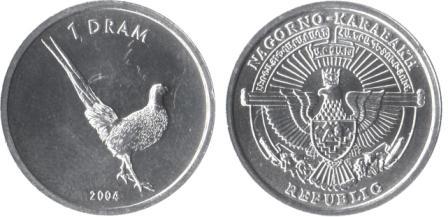 |
KM#8 1
Dram. Year:
2004. Weight:
1.11g [1.15g]. Metal:
Aluminium.
Diameter:
21.70 mm. Edge:
Plain. Alignment:
Medal. Mint:
N/A. Obverse:
"1 DRAM" written on
top. Pheasant
in the center. Date at the bottom.
Reverse:
"NAGORNO-KARABAKH" at the top. Emblem in the
center. "REPUBLIC" at the bottom.
Mintage:
N/A.
Minted Years:
One year type. |
|
 |
KM#9 1
Dram. Year:
2004. Weight:
1.13g [1.15g]. Metal:
Aluminium.
Diameter:
21.70 mm. Edge:
Plain. Alignment:
Medal. Mint:
N/A. Obverse:
"SAINT GREGORY"
written on right side
clock-wise. "1 DRAM" written on left side clock-wise. Saint protrait
in the center. Date at the bottom.
Reverse:
"NAGORNO-KARABAKH" at the top. Emblem in the
center. "REPUBLIC" at the bottom.
Mintage:
N/A.
Minted Years:
One year type. |
|
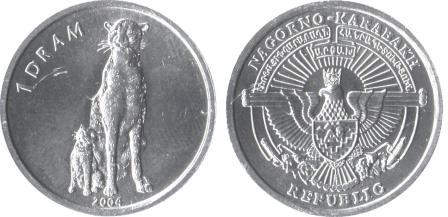 |
KM#10 1
Dram. Year:
2004. Weight:
1.12g [1.15g]. Metal:
Aluminium.
Diameter:
21.70 mm. Edge:
Plain. Alignment:
Medal. Mint:
N/A. Obverse:
"1 DRAM" written on
top left side clock-wise. Cheetah with its kid
in the center. Date at the bottom.
Reverse:
"NAGORNO-KARABAKH" at the top. Emblem in the
center. "REPUBLIC" at the bottom.
Mintage:
N/A.
Minted Years:
One year type. |
|
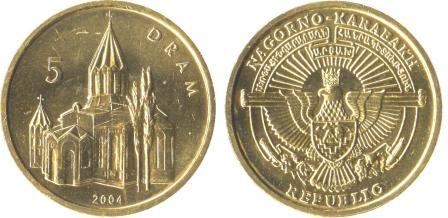 |
KM#11
5
Drams. Year:
2004. Weight:
4.50g [4.50g]. Metal:
Brass.
Diameter:
21.80 mm. Edge:
Plain. Alignment:
Medal. Mint:
N/A. Obverse:
Numeral "5" written
above the cross on the Church. Church
in the center. "DRAM" written on right top side. Date at the bottom.
Reverse:
"NAGORNO-KARABAKH" at the top. Emblem in the
center. "REPUBLIC" at the bottom.
Mintage:
N/A.
Minted Years:
One year type. |
|
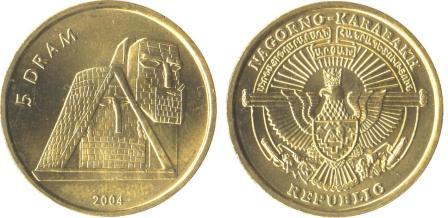 |
KM#12
5
Drams. Year:
2004. Weight:
4.55g [4.50g]. Metal:
Brass.
Diameter:
21.80 mm. Edge:
Plain. Alignment:
Medal. Mint:
N/A. Obverse:
"5 DRAM" written
on left side. Two Monument faces
in the center. Date at the bottom.
Reverse:
"NAGORNO-KARABAKH" at the top. Emblem in the
center. "REPUBLIC" at the bottom.
Mintage:
N/A.
Minted Years:
One year type. |
|
|
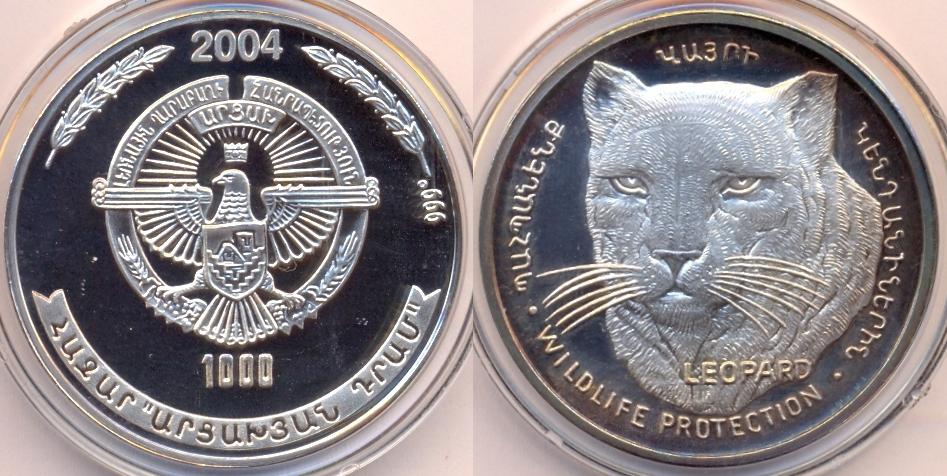 |
KM#19 1000
Drams. Year:
2004. Weight:
31.37g. Metal:
0.999 silver.
Diameter:
38.90 mm. Edge:
Plain. Alignment:
Medal. Mint:
N/A. Obverse:
Date at the
top. National emblem in the center with Numeral "1000" below it.
Armenian language on the banner at the bottom.
Reverse:
Leopard in the center. "LEOPARD WILDLIFE
PROTECTION" at the bottom. Armenian language at the top, left and
right sides.
Mintage:
N/A.
Minted Years:
One year type. |
|
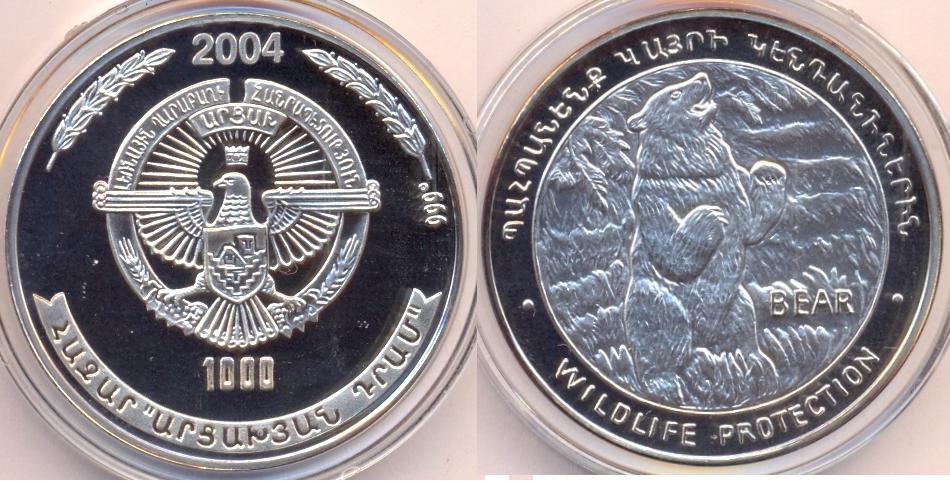 |
KM#20 1000
Drams. Year:
2004. Weight:
31.37g. Metal:
0.999 silver.
Diameter:
38.90 mm. Edge:
Plain. Alignment:
Medal. Mint:
N/A. Obverse:
Date at the
top. National emblem in the center with Numeral "1000" below it.
Armenian language on the banner at the bottom.
Reverse:
Standing brown bear in the center. "WILDLIFE
PROTECTION" at the bottom. Armenian language at the top.
Mintage:
N/A.
Minted Years:
One year type. |
|
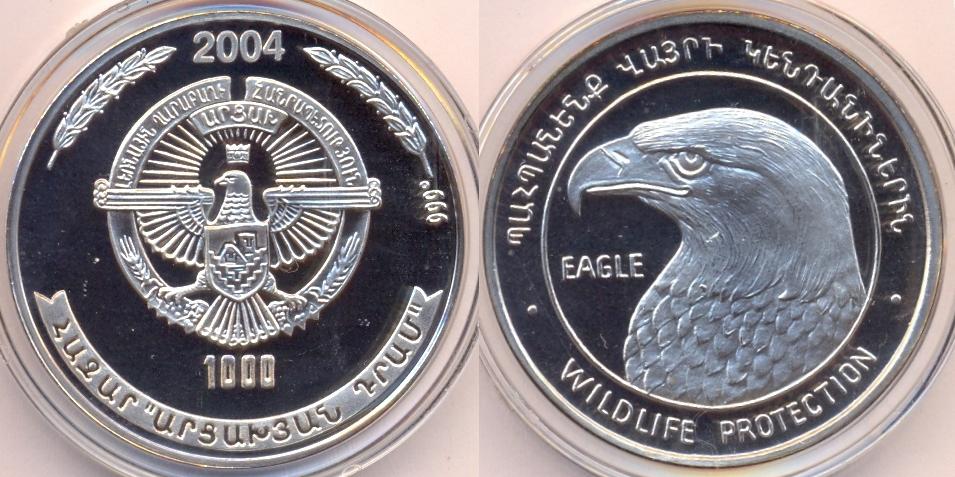 |
KM#21 1000
Drams. Year:
2004. Weight:
31.37g. Metal:
0.999 silver.
Diameter:
38.90 mm. Edge:
Plain. Alignment:
Medal. Mint:
N/A. Obverse:
Date at the
top. National emblem in the center with Numeral "1000" below it.
Armenian language on the banner at the bottom.
Reverse:
Eagle's head facing left in the center.
"WILDLIFE PROTECTION" at the bottom. Armenian language at the top.
Mintage:
N/A.
Minted Years:
One year type. |
|
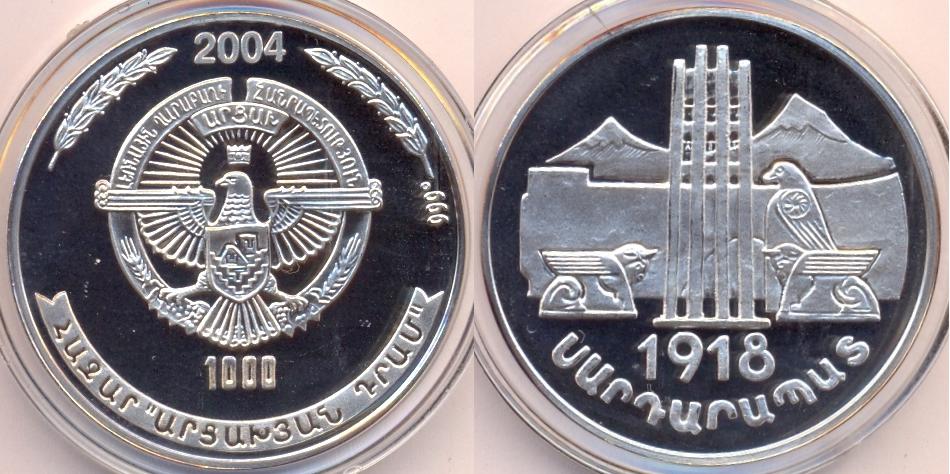 |
KM#22 1000
Drams. Year:
2004. Weight:
31.12g. Metal:
0.999 silver.
Diameter:
38.90 mm. Edge:
Plain. Alignment:
Medal. Mint:
N/A. Obverse:
Date at the
top. National emblem in the center with Numeral "1000" below it.
Armenian language on the banner at the bottom.
Reverse:
1918 Genocide Victims
Monument in the
center. "1918" below this monument and Armenian language at the
bottom.
Mintage:
N/A.
Minted Years:
One year type. |
|
| |
| |
|
On January 25, 2005 PACE adopted Resolution 1416, which
condemns the use of ethnic cleansing against the Azerbaijani population, and
supporting the occupation of Azerbaijani territory. On 15–17 May 2007 the 34th
session of the Council of Ministers of Foreign Affairs of the Organization of
Islamic Conference adopted resolution № 7/34-P, considering the occupation of
Azerbaijani territory as the aggression of Armenia against Azerbaijan and
recognizing the actions against Azerbaijani civilians as a crime against
humanity, and condemns the destruction of archaeological, cultural and religious
monuments in the occupied territories. At the 11th session of the summit of the
Organization of the Islamic Conference held on March 13–14, 2008 in Dakar,
resolution № 10/11-P (IS) was adopted. According to the resolution, OIC member
states condemned the occupation of Azerbaijani lands by Armenian forces and
Armenian aggression against Azerbaijan, alleged ethnic cleansing against the
Azeri population, and charged Armenia with the "destruction of cultural
monuments in the occupied Azerbaijani territories". On March 14 of the same year
the UN General Assembly adopted Resolution № 62/243 which "demands the
immediate, complete and unconditional withdrawal of all Armenian forces from all
occupied territories of the Republic of Azerbaijan". As of August 2008, the
United States, France, and Russia (the co-chairs of the OSCE Minsk Group) are
mediating efforts to negotiate a full settlement of the conflict, proposing a "a
referendum or a plebiscite, at a time to be determined later," to determine the
final status of the area, return for some territories under Karabakh's control,
and security guarantees. Ilham Aliyev and Serzh Sarkisian traveled to Moscow for
talks with Dmitry Medvedev on 02 November 2008. The talks ended in the three
Presidents signing a declaration confirming their commitment to continue talks.
On November 22, 2009, several world leaders, among them the heads of state from
Azerbaijan and Armenia, met in Munich in the hopes of renewing efforts to reach
a peaceful settlement on the status of Nagorno-Karabakh. |
| |
|
2013 |
| |
|
 |
50 luma. Year:
2013. Weight:
1.32g [1.30g]. Metal:
Aluminium.
Diameter:
19.80 mm. Edge:
Plain. Alignment:
Medal. Mint:
N/A. Obverse:
"50 LUMA"
written on the top.
Horse running on right side. Date at the bottom.
Reverse:
"NAGORNO-KARABAKH" at the top. Emblem in the
center. "REPUBLIC" at the bottom.
Mintage:
N/A.
Minted Years:
One year type. |
|
 |
50 luma. Year:
2013. Weight:
1.34g [1.30g]. Metal:
Aluminium.
Diameter:
19.80 mm. Edge:
Plain. Alignment:
Medal. Mint:
N/A. Obverse:
"50 LUMA"
written on the top.
Antelope walking towards left side. Date at the bottom.
Reverse:
"NAGORNO-KARABAKH" at the top. Emblem in the
center. "REPUBLIC" at the bottom.
Mintage:
N/A.
Minted Years:
One year type. |
|
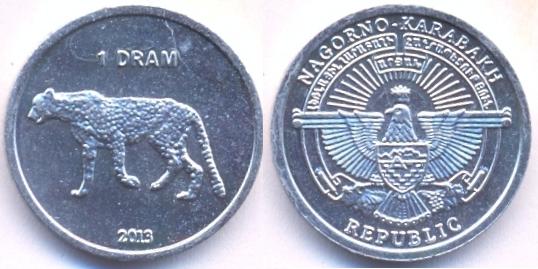 |
1
Dram. Year:
2013. Weight:
1.61g [1.60g]. Metal:
Aluminium.
Diameter:
21.80 mm. Edge:
Plain. Alignment:
Medal. Mint:
N/A. Obverse:
"1 DRAM" written on
top. Leopold walking left
in the center. Date at the bottom.
Reverse:
"NAGORNO-KARABAKH" at the top. Emblem in the
center. "REPUBLIC" at the bottom.
Mintage:
N/A.
Minted Years:
One year type. |
|
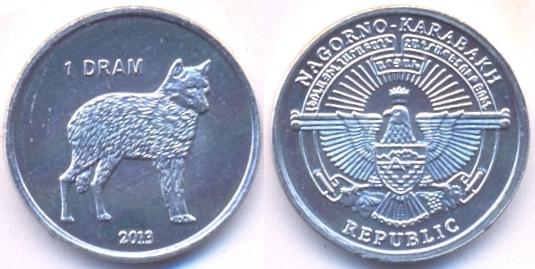 |
1
Dram. Year:
2013. Weight:
1.60g [1.60g]. Metal:
Aluminium.
Diameter:
21.80 mm. Edge:
Plain. Alignment:
Medal. Mint:
N/A. Obverse:
"1 DRAM" written on
top. Wolf facing right
in the center. Date at the bottom.
Reverse:
"NAGORNO-KARABAKH" at the top. Emblem in the
center. "REPUBLIC" at the bottom.
Mintage:
N/A.
Minted Years:
One year type. |
|
 |
1
Dram. Year:
2013. Weight:
1.61g [1.60g]. Metal:
Aluminium.
Diameter:
21.80 mm. Edge:
Plain. Alignment:
Medal. Mint:
N/A. Obverse:
"1 DRAM" written on
top. Pheasant
facing left in the center. Date at the bottom.
Reverse:
"NAGORNO-KARABAKH" at the top. Emblem in the
center. "REPUBLIC" at the bottom.
Mintage:
N/A.
Minted Years:
One year type. |
|
 |
5
Drams. Year:
2013. Weight:
5.59g [5.65g]. Metal:
Brass.
Diameter:
21.80 mm. Edge:
Plain. Alignment:
Medal. Mint:
N/A. Obverse:
"5 DRAM" written on
top right side. Bear moving left in the center. Date at the bottom.
Reverse:
"NAGORNO-KARABAKH" at the top. Emblem in the
center. "REPUBLIC" at the bottom.
Mintage:
N/A.
Minted Years:
One year type. |
|
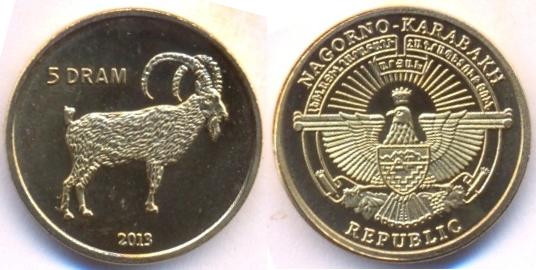 |
5
Drams. Year:
2013. Weight:
5.71g [5.65g]. Metal:
Brass.
Diameter:
21.80 mm. Edge:
Plain. Alignment:
Medal. Mint:
N/A. Obverse:
"5 DRAM" written on
top right side. Capricorn standing facing right in the center. Date at the bottom.
Reverse:
"NAGORNO-KARABAKH" at the top. Emblem in the
center. "REPUBLIC" at the bottom.
Mintage:
N/A.
Minted Years:
One year type. |
|
| |
| |
|
|
| |
|
|
| Countries
/ Territories |
| |
|
Chiefa Coins | |
|


































